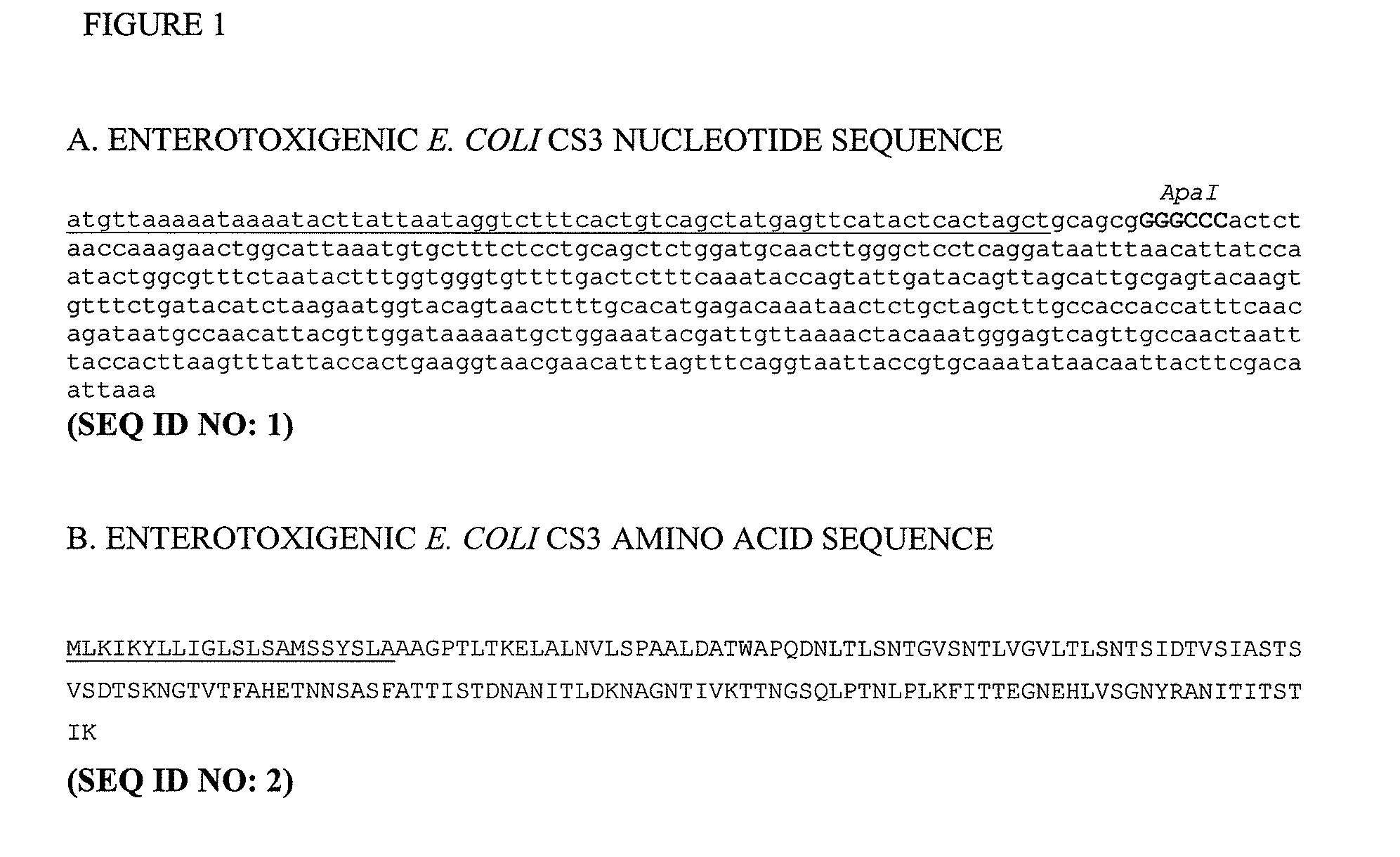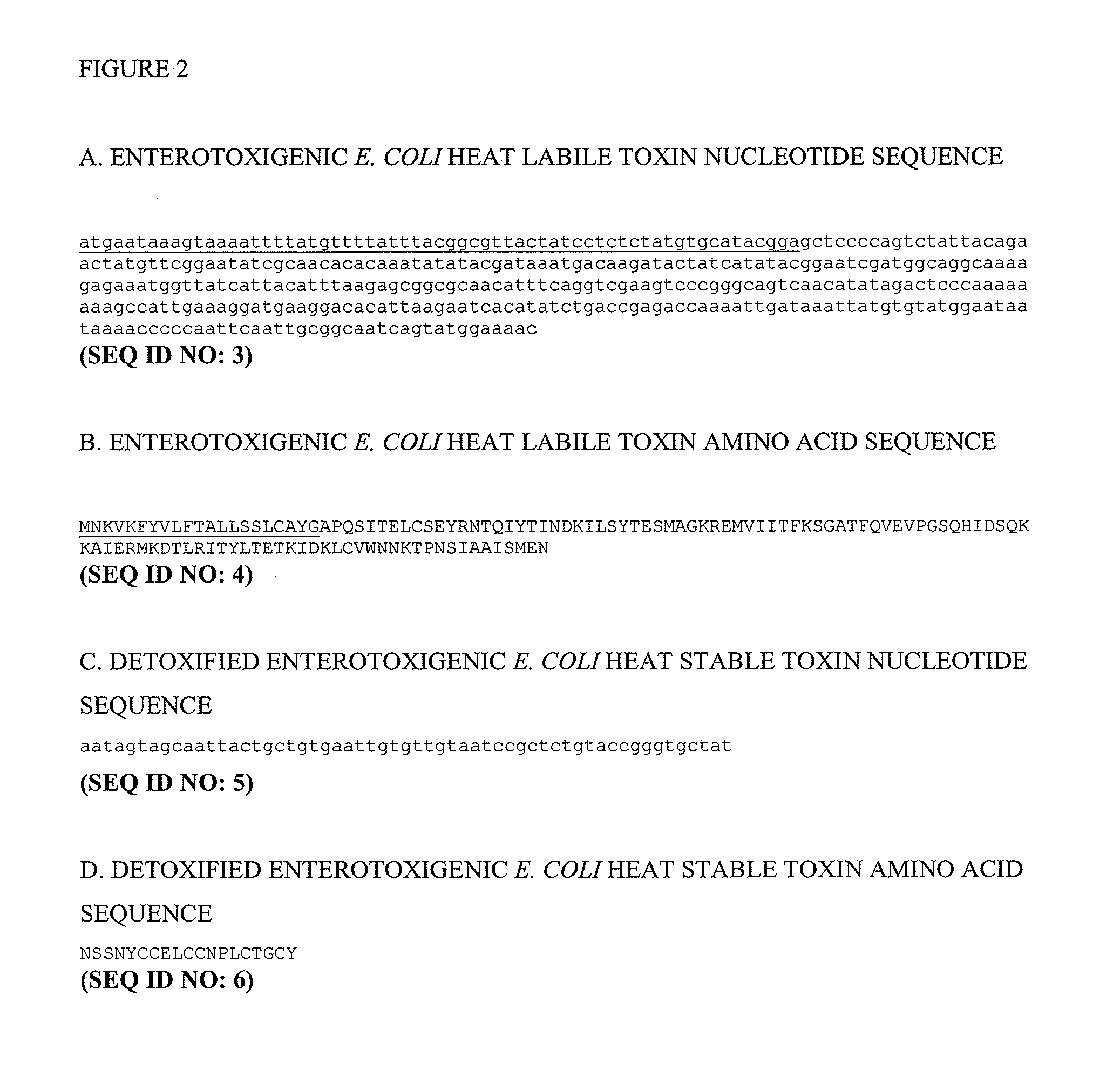Use of e. coli surface antigen 3 sequences for the export of heterologous antigens
a technology of surface antigen and e. coli, which is applied in the field of medicine, immunology, and vaccine development, can solve the problems of challenging the generation of effective immune responses
- Summary
- Abstract
- Description
- Claims
- Application Information
AI Technical Summary
Benefits of technology
Problems solved by technology
Method used
Image
Examples
example 1
Design of CS3 Fusion Constructs
[0158]Although the following example describes CS3 fusion constructs containing antigens from enterotoxigenic E. coli (ETEC), it is to be understood that any heterologous antigen can be used with the CS3 export signal sequence in the fusion construct.
CS3 Signal Peptide:Ltb:ST Fusion
[0159]A first construct is created containing the export signal sequence from the ETEC surface antigen, CS3. The nucleotide and amino acid sequence of the export signal from CS3 antigen is shown below:
Nucleotide Sequence of CS3 Export Signal Sequence:
[0160]
(SEQ ID NO: 7)atgttaaaaataaaatacttattaataggtctttcactgtcagctatgagttcatactcactagct
Amino Acid Sequence of CS3 Export Signal Sequence:
[0161]
(SEQ ID NO: 8)MLKIKYLLIGLSLSAMSSYSLA
[0162]The export signal sequence is isolated from the full length CS3 sequence using the natural restriction site for ApaI (See underlined nucleotides in FIG. 1A). The CS3 export signal sequence is placed under the control of a Salmonella ssaG promoter u...
example 2
Construct Containing C. difficile Toxin B Full Length CS3 Fusion
[0172]E. coli codon optimized crdB will be isolated from pPCRscript FAFB as a Sma I / Avr II fragment and cloned into the corresponding sites in the pMBS CS3 ST vector, thereby creating a CS3 crdB fusion protein. Following confirmation of the structure of this vector the promoter CS3 crdB fusion will then be isolated as a Xho I / Avr II fragment and sub cloned into a suicide vector based on pCVD442. This suicide vector will have been previously engineered to contain DNA sequence derived from the intended integration site in the S. typhi genome, which will have been modified to include Xho I and Avr II sites at the insertion site, as in, for example, the pCVDaro or pCVDssaV suicide vector.
[0173]Suicide vectors derived from pCD442 contain the R6k origin of replication which requires the lambda phage pir protein to allow replication in plasmid form. Following transfer of the plasmid into Salmonella by chemical or elctro transf...
example 3
Construct Containing C. difficile Toxin B CS3 Signal Peptide Fusion
[0174]In order to construct the promoter CS3 signal peptide crdB fusion, E. coli codon optimized crdB fusion from pPCRscript FAFB will be amplified by PCR amplification using primers designed to introduce an Apa I restriction endonuclease recognition site at the 5′ end of the crdB sequence and retaining the Avr II site present at the 3′ end. The PCR product will then be cloned between the Apa I / Avr II sites present in the pMBS CS3 ST vector. Following confirmation of the structure of this vector, the promoter CS3 crdB fusion will then be isolated as a Xho I / Avr II fragment and sub cloned into a suicide vector based on pCVD442. This suicide vector will have been previously engineered to contain a DNA sequence derived from the intended integration site in the S. typhi genome, which will have been modified to include Xho I and Avr II sites at the insertion site, for example this suicide vector could be pCVDaro or pCVDss...
PUM
| Property | Measurement | Unit |
|---|---|---|
| Composition | aaaaa | aaaaa |
| Immunogenicity | aaaaa | aaaaa |
Abstract
Description
Claims
Application Information
 Login to View More
Login to View More - R&D
- Intellectual Property
- Life Sciences
- Materials
- Tech Scout
- Unparalleled Data Quality
- Higher Quality Content
- 60% Fewer Hallucinations
Browse by: Latest US Patents, China's latest patents, Technical Efficacy Thesaurus, Application Domain, Technology Topic, Popular Technical Reports.
© 2025 PatSnap. All rights reserved.Legal|Privacy policy|Modern Slavery Act Transparency Statement|Sitemap|About US| Contact US: help@patsnap.com



